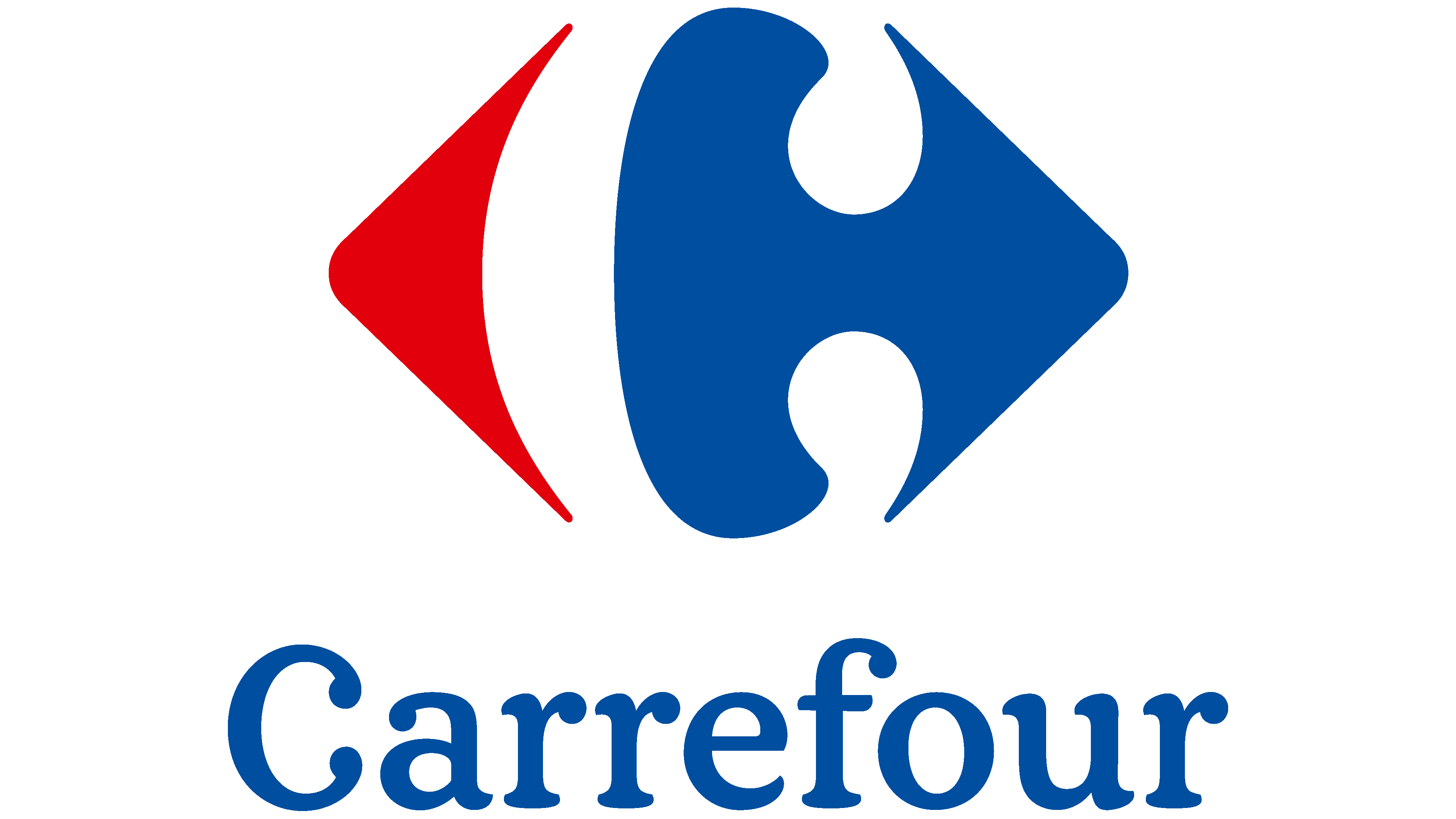Carrefour Logo
Carrefour, a global retail titan, currently operates supermarkets, hypermarkets, and convenience stores. Originally from France, the company has expanded its reach across Europe, Asia, and South America, being one of the world’s largest retail chains. Today, Carrefour’s major markets include France, Spain, and Brazil. While the brand has faced competition from e-commerce platforms, it continues to innovate its in-store and online shopping experience. The enterprise is publicly traded, with shareholders owning the majority of its equity. Carrefour’s commitment to sustainable and local products sets it apart in the ever-evolving retail landscape.
Meaning and history
Carrefour, birthed in France in 1958 by Marcel Fournier and Louis Defforey, pioneered the hypermarket concept, blending a supermarket and a department store. The first Carrefour store debuted in Annecy in 1960, setting the stage for rapid growth. The 1970s saw the company’s foray into international territories like Spain and Brazil.
Carrefour’s innovation-driven ethos led to the establishment of the first European hypermarket in Belgium in 1969. In the ’80s and ’90s, the retailer further expanded its global footprint, entering Asia and the Middle East, with countries like China and Taiwan witnessing its presence.
The 2000s marked a period of mergers and partnerships. Notably, in 2000, Carrefour merged with Promodès, one of its top competitors, solidifying its European leadership. However, it faced challenges in markets like Japan and Russia, eventually exiting them.
Ownership remained predominantly with the founding families until the ’70s, after which shares became publicly traded. Although the company witnessed management shifts, its essence as a consumer-focused entity remained intact. Over time, Carrefour adapted its business model to changing market needs, introducing organic product lines and investing in e-commerce capabilities.
Today, Carrefour stands as a testament to evolving consumer needs, with a rich history spanning over six decades, and continues to be a dominant figure in the global retail landscape.
1960 – 1963
The inaugural logo showcased an abstract depiction of a crossroads, featuring a prominent white cruciform crafted from broad bands set against a dark diamond backdrop. Inscribed on the horizontal band was the firm’s moniker, penned in sleek, dark-hued lowercase typography. This design not only encapsulated the essence of the brand but also hinted at the company’s core values and vision, emphasizing the intersection of quality and value. The simplicity of the emblem underscored the brand’s straightforward approach, while the choice of colors offered a stark yet appealing contrast.
1963 – 1966
In the early months of 1963, the brand underwent a significant transformation in its emblem’s design. The logo took on a circular shape and adopted a striking red hue. While the firm’s title continued to be prominently displayed on an expansive white horizontal band, the previous vertical element underwent a metamorphosis. It was now symbolized by a pair of bold white arrows. This redesign reflected the brand’s evolving vision and highlighted its forward-moving ethos, with the arrows serving as a testament to its dynamic trajectory and ever-expanding horizons in the business world. The color palette and shape choices also underscored the brand’s passion and commitment to growth.
1966 – 1972
The logo underwent another comprehensive revamp, this time aligned with the “Embrace the Positive” initiative. Drawing inspiration from France’s iconic tricolor – white, blue, and red – the design showcases the brand’s name in vibrant blue against a pristine white backdrop. Hovering above the name are a pair of arrows: one in vivid red and the other in blue, each pointing in opposite directions. Intriguingly, the blue arrow appears almost fused with the letter “C”, representing the very essence of the company. These intersecting arrows symbolize the crossroads of choice and underscore the brand’s core principles: delivering exceptional value for cost, thereby resonating with its customer base. This redesigned emblem captures the brand’s forward-thinking approach and its dedication to serving its patrons.
1972 – 1982
The emblem retained its fundamental essence and visual appeal. However, the dimensions underwent a tweak — the brand’s moniker shrank, while the symbol itself was amplified significantly. This strategic shift underscored the brand’s unwavering commitment to delivering superior quality at pocket-friendly prices. The newly adjusted proportions were an eloquent testament to the company’s core philosophy: ensuring that excellence in both product and value takes center stage, signaling their dedication to a customer-first approach and emphasizing the significance they place on delivering value without compromising on quality.
1980 – 1982
Alterations to the Carrefour emblem predominantly centered on its hue, with the characteristic bidirectional arrows still in place. The original blue underwent a transition to a shade of violet. Furthermore, the typography underwent subtle refinements: the contours of the characters became more fluid and had a curvier demeanor. Adjustments were made to the ‘r’, with the top space getting minimized, while the ‘f’ acquired a more rounded bend. A shift from a lowercase to an uppercase ‘c’ was another noticeable transformation, accompanied by a slight trimming of the serifs, bringing a fresh yet familiar feel to the brand’s visual identity.
1982 – 2010
The enterprise further amplified the dimensions of its brand’s nomenclature to enhance brand visibility and recognition. While the color palette remains unaltered, the accompanying text linked to the emblem underwent a typographical transformation. The lettering now showcases softened serifs, giving the words a more rounded appearance. Emphasizing the brand’s distinctiveness, the entire set of characters has been boldened, conveying strength and prominence in its presentation. This strategic shift was designed to foster deeper connections with consumers and make the brand’s identity unmistakably clear in the competitive market landscape.
2010 – Today
The Carrefour logo, a harmonious blend of vibrant colors and distinctive shapes, embodies the essence of one of the world’s most recognized retail brands. The design showcases two primary-colored arrows – one in bold red and the other in a striking shade of blue. These arrows, pointing in opposite directions, ingeniously form a negative space in the center that alludes to the shape of the letter “C”, an evident nod to the company’s name, “Carrefour”.
The two arrows are emblematic of a crossroads, resonating with the literal translation of “Carrefour” from French to English as “crossroad”. This clever design choice communicates the idea that Carrefour is the intersection of variety, quality, and value – a place where diverse product choices converge. The white space in between the arrows is more than just a stylistic choice; it offers breathing room and balance to the overall design, creating an illusion of fluid motion.
Below the graphic element, we find the brand’s name, “Carrefour”, in a clear and readable blue serif font. This typography, with its classic undertones, lends an air of reliability, trustworthiness, and tradition. While the upper portion of the logo emphasizes innovation and dynamism, the textual element grounds the design, conveying the brand’s rich history and its commitment to customer satisfaction. Together, these components coalesce into a logo that is both modern and timeless, a true representation of Carrefour’s legacy and its forward-looking vision.


















